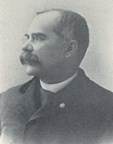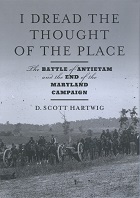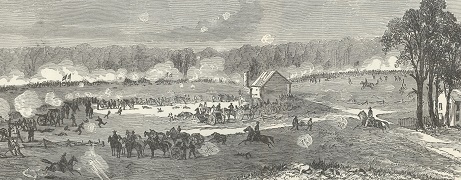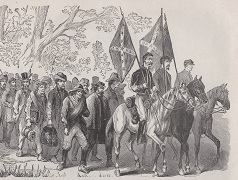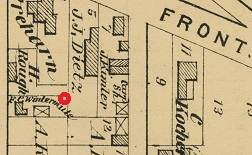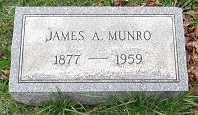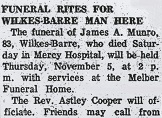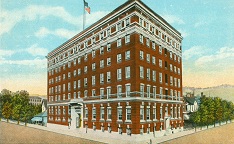
|
Katherine
Salkeld 'Kate' |
|
|
|
Kate and Frank Wintermute |
Katherine Salkeld "Kate" (Miner) Wintermute was born on Dec. 4, 1842 in Mauch Chunk, Carbon County, PA, the daughter of Elias and Mary (Cook) Miner.
She went by the various names and nicknames of Kate, Kate Salkeld, Catharine, Catharine M. and Katherine, causing confusion with federal authorities later in her life. Her husband was a veteran of the Civil War.
As a young lady, and the daughter of a prominent industrialist, Kate received her education at the Park Academy, a girls' school located on Packer Hill in Mauch Chunk.
Kate wed Franklin Charles "Frank" Wintermute (1840-1920), son of Joseph B. and Judith Ann (Shoemaker) Wintermute (also spelled "Wintermuth"). They were wed after Frank returned home from the army during the Civil War. The ceremony took place on April 3 (or 18 or 23 or 26), 1865, when Kate was age 23 and Frank 25. Rev. J.W. Wood conducted the ceremony in the Presbyterian church in Allentown, Lehigh County, PA.
A native of Stroudsburg, Monroe County, PA, Frank moved to Weissport, Carbon County, when a boy of five. He stood 5 feet, 9 inches, with a light complexion, blue eyes and dark hair, and labored as a farmer at the start of the war.
During the Civil War, Frank enlisted in Lehighton on Aug. 9, 1862 in the 132nd Pennsylvania Volunteer Infantry, Company F. Others in the family serving in the same regiment were his brother-in-law William Henry. Miner and his wife's cousin Alexander Mills.
~ A Heroic Stand at the Bloody Lane at Antietam ~
 |
| Above: dead in the Bloody Lane/Sunken Road at Antietam. Below: monument to the 132nd Pennsylvania (left) in the sunken lane. Library of Congress |
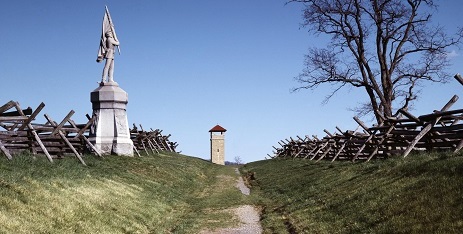 |
The 132nd Pennsylvania quickly made a mark of distinction at Antietam on Sept. 17, 1862, where 22,726 men on both sides were killed, wounded or missing. It was the single bloodiest day on American soil, ever. In an astonishing twist, Frank and his brother-in-law were among five members of the extended Miner family to be present that day. At the Bloody Lane/Sunken Road, their regiment fought alongside two others from two other states, including the 8th Ohio Infantry (with William "Henry" Alderman) and the 7th West Virginia Infantry (including James Eyster Murdock Sr.).

Writing in Landscape Turned Red, author Stephen W. Sears says that at the sunken lane, "Brigaded with the veterans was the new 132nd Pennsylvania, another of Governor Curtin's nine-month regiments, and the rookies were visibly apprehensive. 'An occasional shell whizzed by or over, reminding us that we were rapidly approaching the "debatable ground," one of them wrote. 'The compressed lip and set teeth showed that nerve and resolution had been summoned to the discharge of duty. A few temporarily fell out, unable to endure the nervous strain, which was simply awful..."
|
Hartwig's book Johns Hopkins University Press |
They crossed Antietam Creek and could tell “that a great battle was in progress,” Hitchcock wrote. “A deafening pandemonium of cannonading, with shrieking and bursting shells, filled the air beyond us, toward which we were marching.” The men began to hear the cracks of musket fire and added to cannon blasts the effect was terrifying. Hitchcock noted that the gunfire from afar sounded just like “the rapid pouring of shot on a tinpan, or the tearing of heavy canvas.” As he observed the expressions on his fellow soldiers’ silent faces, he could tell that the stress “was simply awful.”
When the 132nd reached the sunken road, they encountered troops from Alabama and Georgia which were putting pressure on their left side, or flank. The Pennsylvanians were ordered to refuse the flank, meaning a bending or turning to allow for face-to-face combat. Remembered Commodore P. Mears of the regiment, “We fired such a voley into them that they soon went back and with less men.”
In his book I Dread the Thought of That Place, D. Scott Hartwig says that the fighting at the sunken road was a “lethal slugfest.” The 132nd Pennsylvania began to pour heavy fire into parts of the 6th Alabama and 2nd North Carolina. “Combined with the volleys from this front,” Hartwig writes, “this brought a withering crossfire against both of these exposed points on the Confederate line.” Some enemy soldiers tried to escape on foot but were mowed down as they ran. Mears of the 132nd recalled that “some of the rebs in the pit tried to make their escape through the cornfield but there was but very few that would reach the top of the hill till they would get layed [out].” The tide finally turned in the favor of the 132nd.
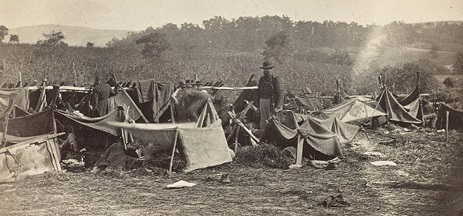 |
| Army aid station after the Battle of Antietam - Alexander Gardner/Library of Congress |
As an example of the savage losses of the day at the sunken lane, the 14th North Carolina suffered 52 percent casualties and the 2nd North Carolina some 44 percent.
An army aid station was established on the local farm fields with dreadful sights and sounds. That evening, Hitchcock of the 132nd discovered that wounded troops were sprawled on the ground “so thickly that there was scarce room for the surgeons and their attendants to move about among them.” He witnessed many “piles of amputated arms, legs, and feet, thrown out with as little care as so many pieces of wood.”
|
|
|
Above, the Battle of Chancellorsville, as sketched by Edwin Forbes. Below, troops under Gen. Reynolds en route to the battle, and Confederate POWs brought in. |
|
|
~ Chancellorsville and a Return Home ~
Frank is believed to have seen action in the Battle of Chancellorsville. He received his honorable discharge at Harrisburg and finally at Catasauqua, Carbon County in late May 1863.
The couple went on to produce five known children -- Horace Miner Wintermute (born 1866), Joseph Elmer Wintermute (1868), Maude E. Munro (1872), Miriam Cook Hess (1875) and Russell Kirby Wintermute (1881).
The family first lived in Catasauqua, Lehigh County, PA, and thence moved to Weissport, Carbon County. In 1867, Frank accepted a position as clerk in the coal department of the Lehigh Valley Railroad. Said the Mauch Chunk Daily News, "After his return from the war he became a leading clerk at the Packerton Forwarding office and was held in high esteem by the company's officials. The Packerton forwarding office was then in its prime."
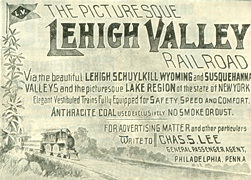 |
| Ad for Frank's employer, the Lehigh Valley Railroad, in The Chautauquan, October 1894 |
Eventually, in 1869, they relocated for good to East Mauch Chunk, where they remained for the rest of their lives. Frank's employment circa 1870-1900 was as a railroad clerk. One of his longtime co-workers was Ben F. Kuehner, of the railroad clerk's office at Packerton. The family were members of the Grace Methodist Church.
The 1880 census shows Frank's widowed mother, age 58, living under their roof on South Street in East Mauch Chunk. This family was listed in the 1895-1897 book Annals of Our Colonial Ancestors and their Descendants, by Ambrose Milton Shotwell.
Frank suffered a debilitating injury on the night of Nov. 28, 1882, at the age of 62, when he was struck by a moving locomotive at Lehighton. In his words:
Was run over by a locomotive, foot crushed, and amputated above the ankle, the train came in on the South bound track, instead of the North as that was the track on which it should have come. I stepped off the depot platform and was in the act of crossing the South bound track, and was caught and injured as above stated. I had a very sore eye which was bandaged, and the strong light from the Engine's head-light was so bright that it hurt my good eye, consequently I did not see that the North bound train was coming on the South bound track.
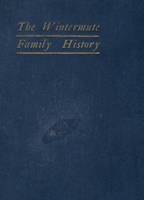 |
| Wintermute Family History, published 1900 |
When the Atlas of Carbon County was published in 1875 by F.W. Beers & Co., Frank and Kate's home was identified and marked on the page featuring East Mauch Chunk. Their home was on South Street, in between Second and Front Street, and just a half block from the town's commons. The map shows that not only did they have a home on their narrow tract, but also a rectangular outbuilding in the back. In a list of atlas subscribers published on the same page, Frank is mentioned.
In 1892, Frank received payment of $2,145.56 from the Commonwealth of Pennsylvania. This was compensation for services he provided to schools in Carbon County, but details are not yet known. He also is known to have begun drawing a pension for his service in the war in September 1890. His paperwork is on file today at the National Archives in Washington, D.C. [Invalid Application #919.578, Invalid Certificate #699.675; Widow Application #1.160.715, Widow Certificate #894.351]
|
|
|
Red dot marks Frank and Kate's
town lot on |
|
|
He subscribed to the publication The Elevator Constructor, a trade journal of the International Union of Elevator Constructors. The magazine asked readers to respond to the question, "What is the difference between labor union and trusts?" Frank answered in writing, with his comments published in the April 1904 issue: "The trust is organized by the capitalistic class for the purpose of accumulating more of the wealth that the industrious world creates, while the labor unions are organized by the wealth producers of the world, so that they may be able to retain more of the wealth that they create."
Frank enjoyed socializing with former Civil War veterans in Mauch Chunk. He was active with the local L.T. Chapman Post No. 61 of the Grand Army of the Republic, a veterans organization. In June 1899, he took part in the 33rd annual GAR encampment in Pennsylvania, held that year in Wilkes-Barre, PA.
In 1900, the census lists the Wintermutes in East Mauch Chunk. Frank, age 56, was employed as a clerk in a railroad office. Son Russell, age 19, worked as a "drug clerk," while daughters Maude (age 28) and Miriam (24) had no occupation.
Kate was mentioned in the 1918 Mauch Chunk Daily News obituary of her relative Sophia Heilman, which noted that the two were cousins.
The census of 1920 shows the family living on 117 South Street in East Mauch Chunk, with 40-year-old daughter Maude making her home under their roof, and working as a private duty nurse for her parents.
|
|
| Dimmick Memorial Library |
In retirement, Frank served as librarian at the Dimmick Memorial Library in Mauch Chunk, circa 1906, when he would have been 66 years of age. The library was opened 16 years earlier, on Oct. 1, 1890, and was built of Jacobean design just a block from the Carbon County Courthouse At the time Frank worked there, the library had 15,000 volumes. (It later was named to the National Historic Register, and survived a disastrous fire in 1979, in which some 19,200 volumes were destroyed. In an ironic twist, family researchers visited the library and made marvelous discoveries about the Wintermutes and Miners in April 2013.)
|
|
| Front page, Mauch Chunk Daily News, June 14, 1920 |
The Wintermutes grieved in June 1918 when they learned of the death of their son Horace, who had been living in Colorado.
Family physician Dr. J.E. Weaver of East Mauch Chunk described Frank's deteriorating health as he aged. Writing in 1920, he said:
Until 15 years ago treated him at rare intervals for abscess of stump of leg where amputated (right, middle third). For past fifteen years vision has been progressively failing, until now is not able to read, with glasses. He was employed at clerical work until 15 years ago, when he was obliged to stop work, on account of eyes, and generally debilitated condition. For past six years the mentality has been failing (senility). Physically, is not able to move about, must be assisted from chair to bed and vice versa.
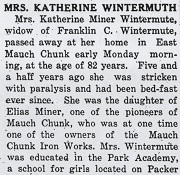 |
| Lehighton Press, April 17, 1925 |
Also suffering from his own stroke of paralysis, Frank passed away eight and a half months after Kate's stroke, on June 14, 1920 at the age of 79. His death ended a marital union of more than 55 years.
He was laid to rest in the Evergreen Cemetery in Mauch Chunk (Jim Thorpe), with funeral arrangements handled by local undertaker David DeFrehn. A front-page obituary in the Mauch Chunk Daily News said he "was one of the few surviving members of L.F. Chapman Grand Army Post [and] had been an invalid for some time and for the past week or two as very feeble."
Kate outlived her husband by five years, in the constant care of their daughter Maude. She was awarded Frank's Civil War pension, but at the reduced monthly amount of $30, despite Maude's frequent letters and petitions to the Commissioner of Pensions.
Kate died in 1925 and also rests in the Evergreen Cemetery, Plot 73-F. (link) Her obituary in the Lehighton Press noted that she "was a daughter of Elias Miner, one of the pioneers of Mauch Chunk, who was at one time one of the owners of the Mauch Chunk Iron Works."
|
|
| The Wintermutes' graves at Evergreen Cemetery in what today is Jim Thorpe, PA |
~ Son Horace Miner Wintermute ~
Son Horace Miner Wintermute (1866-1918) was born Aug. 11, 1866 at Catasauqua, Lehigh County, PA.
On Sept. 15, 1891, at the age of 25, Horace wed Laura Barber (Oct. 17, 1865-1952), the daughter of George F. and Martha E. Barber. The wedding was held in the bride's residence at 304 Adams Avenue in Scranton, Lackawanna County, PA. Jointly officiating were Rev. H.K. Boyer and Rev. Richard Hiorns. In announcing the marriage, the Scranton Tribune called the couple "well known and highly esteemed young people" and said that "The interior of the house was brilliantly illuminated and tastefully decorated with flowers and potted plants. In an alcove in the rear parlor beneath an arch of evergreens the ceremony was performed... The bride wore a neat costume of white landsdowne with lace trimmings and carried a bouquet of pink roses."
They together produced one known daughter, Ruth B. Wintermute.
Circa 1900, the Wintermutes made their home in Scranton, Lackawanna County, PA, and also at 337 Ninth Street in Brooklyn, NY. A paragraph in J.P. Wintermute's 1900 book, The Wintermute Family History, said that "By trade he is a printer and a member of the Typographical Union." The federal census of Scranton of 1900 confirms Horace's occupation as a printer.
During the 1900s, the marriage dissolved in divorce. Laura remained in Scranton at the address of 524 Myrtle Street.
Horace made a major move to Colorado, settling in Berkeley, Jefferson County. The 1910 census counts Horace and his second wife, also named Laura (1883- ? ), as living on Sheridan Boulevard in Berkeley, and having been married for five years. Laura was a Nebraska native, and there was a 16-year difference in their ages. That year, in 1910, Horace worked as a compositor in a print shop.
Sadly, Horace died in Denver on June 6, 1918. No cause is yet known. In an obituary, the Philadelphia Inquirer said his "was the first death in the Wintermute family. His body was cremated."
Former wife Laura remained in Scranton and in 1914 sued to prevent G.J. Babcock and Martha E. Barber from selling a family-owned lot on Adams Avenue. Her address that year was 524 Myrtle Street. By 1920, she tied the knot with farmer Tinis Gumaer (1868- ? ) and moved to Benton, Lackawanna County. They took in their young granddaughter Margaret after the girl's parents divorced. Laura died in Daytona Beach, FL on the next-to-last day of 1952. The body was shipped to New York for interment in Albany Rural Cemetery in the town of Menands.
Daughter Ruth B. Wintermute (1899- ? ) was born on June 12, 1899 in Scranton. She earned income in young womanhood as a clerk. On Sept. 16, 1914, in Binghamton, NY, when she was 16 years of age, she entered into marriage with 21-year-old machinist Alton Eugene Swingle (Dec. 3, 1892-1952). Rev. John J. Lawrence officiated in the parsonage of the First Presbyterian Church. News of the union was announced in the Scranton Times-Tribune. Alton originally was from Sterling, PA and the son of Calvin E. Prat and Elizabeth (Lesher) Swingle. The newlyweds established a home in Scranton at 613 Linden, with Alton working as a railroader in the Scranton shops of the Delaware, Lackawanna and Western Railroad. One daughter born to the couple was Margaret Louise Johnson Green. By 1918, Alton had moved to 512 Washington Avenue, Scranton. At the outbreak of World War I, he joined the U.S. Army and was assigned to the 155th Depot Brigade. He received his honorable discharge on Aug. 12, 1919. Evidence suggests that their union dissolved within a few years and that by 1920 Alton moved back into his mother's residence in Scranton. He married again on Dec. 2, 1927 to Ida Jane Hollenback (1900-1943). By 1934 they relocated to Portland Point, Tompkins County, NY. He died on May 6, 1952. Ruth's fate is not known.
- Granddaughter Margaret Louise Swingle (1915-1985) was born on July 6, 1915 in Scranton's Hahnemann Hospital. Dr. S.E. Breslau assisted in the birth. After her parents divorced, she went to live with her grandmother Laura (Barber) Wintermute Gumaer in Benton, Lackawanna County. She made her way to the District of Columbia. Although not confirmed, evidence suggests that she was twice married, first to Horace Brooks Johnson Sr. (April 5, 1906-1946), originally from the District of Columbia. The known offspring of this coupling were Ridgley Van Johnson, Horace Brooks Johnson Jr., Stanley Thadeus Johnson and Lillian Johnson. The federal census enumeration of 1940 shows this family in two places -- in Washington, DC, with Horace working as a government clerk -- and in Asheville, Buncombe County, NC, where he had a job as a post office clerk. As of 1940, their address in Asheville was 12 Twilight Street and in 1942 was 191 Brevard Road. The shroud of grief descended upon the Johnsons when Horace Sr. passed away in Washington at the age of 40 on Sept. 25, 1946. The body was lowered into rest in Glenwood Cemetery in the District of Columbia. She wed second to Richard Lindsey Green Sr. (Aug. 15, 1913-2005), the son of Danridge M. and Eva (Price) Green of Colonial Beach, VA. The pair remained together for 46 years until the separation of death. The children or stepchildren in this second family were Linda L. Barnhouse, Eva C. Carter, Richard L. Green Jr., Margaret-Ann Breeden, Marian A. Carter and Danridge M. Green. Sadly, Margaret died in Sharpsburg, MD on Jan. 4, 1985. Burial was in Laytonsville United Methodist Church Cemetery in Maryland. Richard remained in Sharpsburg to the end. He passed away at age 92 on Nov. 27, 2005. Inscribed on his grave marker is the epitaph "His eye is on the sparrow."
Great-grandson Ridgley Van Johnson (1937-2006) was born on New Year's Day 1937 in the District of Columbia. He was the father of three daughters. Ridgley wed Marlene Hart ( ? - ? ) who brought three stepsons into the family. They moved in about 1996 to Bell, FL. He earned a living in maintenance services and was employed by Gilchrist Building Supply in Bell. At the age of 69, death spirited him away on June 24, 2006 as a patient in North Florida Regional Medical Center. Interment was in Hardeetown Methodist Cemetery in Chiefland, FL. An obituary was published in the Gainesville Sun.
Great-grandson Horace Brooks Johnson Jr. (1938-1999) was born in 1938 in the District of Columbia. When he was age 21, on June 24, 1960, in Boydton, VA, he tied the marital cord with 17-year-old Betty Lou Chatham ( ? - ? ), daughter of James M. and Pauline Bertha (Stanbridge) Chatham of Virginia. Officiating was Rev. Grover C. Jenings Jr. of the Methodist Church. At the time of marriage Horace earned a living as a waterman.
Great-grandson Stanley Thadeus Johnson (1941-2010) was born in 1941 in Buncombe County, NC. A bachelor at age 19, he worked as a mechanic in an auto body business in Dunbrooke, VA. On Nov. 19, 1960, he wed 18-year-old telephone clerk Alma Bristow Dunn ( ? - ? ), daughter of Wilbert Bristow and Alma Lee (Davis) Dunn. Rev. Luke Robert Fleming Jr., of the local Baptist church, performed the marital rites in Essex County, VA. The known daughter they produced together was Michelle Renee Johnson. Stanley surrendered to the angel of death in Hanover, VA on Aug. 22, 2010.
Great-granddaughter Lillian Johnson (1944-2004) was born on Oct. 5, 1944 in Colonial Beach, VA. She died on July 30, 2004.
~ Son Joseph Elmer Wintermute ~
Son Joseph Elmer Wintermute (1868-1940) was born on Dec. 7, 1868 in Weissport, Carbon County.
On Nov. 6, 1897, at the age of 28, he was joined in wedlock with Florence Crawford (Dec. 1, 1876-1934), daughter of Capt. William and Eliza (Bennett) Crawford of Hammonton, NJ,
They had three children, two of whom are known -- Doris R. Frommer and Franklin Landis Wintermute.
The couple is mentioned in J.P. Wintermute's 1900 book, The Wintermute Family History. According to the book, "By trade he is a watchmaker and jeweler at Philadelphia. He is a member of the Masonic fraternity and affiliated with Lodge No. 61 at Wilkes-barre, Pa." At the time, their address was Coatesville, Chester County, PA.
The 1910 census of Coatesville shows the Wintermutes residing on Railroad Street, with Joseph's occupation given as "clerk - jewelry store." By 1920, possibly with the opportunity for Joseph to own his own jewelry establishment, or for Florence to return to her home state, the family moved to Woodbury, Gloucester County, NJ. There, as shown in the 1920 census, Joseph's occupation was "jeweler."
 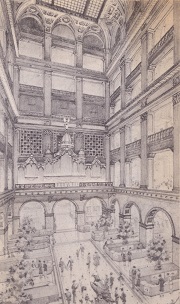 |
| Joseph Wintermute's workplace, the famed Wanamaker Store in Philadelphia, and its soaring interior grand court |
Neither Joseph nor Florence have been found in the census of 1930. For the last 18 years of his career, he was employed as a jewelry salesman with the John Wanamaker Store in Philadelphia. He held a membership in the Wilkes-Barre Lodge of the Masons. In the early 1930s, Joseph's address was 4206 Woodland Avenue in Drexel Park and Florence's was 50 North St. Bernard Street.
Florence suffered from a serious gangrene infection in one of her feet. The family was plunged into mourning when she contracted septcemia and died in Philadelphia at the age of 58 on Jan. 22, 1934. The remains were interred in Locustwood Memorial Park in Cherry Hill, NJ.
Joseph spent his final years with his daughter Doris Frommer in Tuckerton, NJ. He passed away there in late July 1940. Burial was in Locustwood, with an obituary appearing in the Mauch Chunk Times-News.
Daughter Doris R. Wintermute (1901-1991) was born in 1901. She married Norman F. Frommer (1896-1952). Two children produced in this marriage were Paul Frommer and Lois Stewart Holmes. Circa 1931-1940, they dwelled in Tuckerton, NJ. At some point they may have lived in Atlantic City where he ran the local movie theatre. Later they moved to Beach Haven Terrace. They belonged to St. Thomas Roman Catholic Church, and Norman held memberships in the Beach Haven lodge of the Moose, Motion Picture Theatre Operators Union 307 in Philadelphia and the Tuckerton Old Home Society where he was a director. He also was in charge of the "Beauty Queen of Ocean City" contest in 1950, held as part of the Long Beach Township Lifeguards Ball. Norman surrendered to the angel of death at the age of 55 on July 25, 1952 as a patient in Philadelphia's Temple Hospital. Said the Press of Atlantic City, "He had been in ill health more than a year and had returned to the hospital only a week ago." Burial was in Greenwood Cemetery in Tuckerton following a funeral mass in the family church. Doris lived for another nearly four decades as a widow. She died on Nov. 20, 1991, in Pinellas County, FL.
- Grandson Paul Frommer enlisted in the U.S. Navy during the early months of World War II in March 1942.
- Granddaughter Lois Frommer (1924-2005) was born on Jan. 27, 1924 in Philadelphia. She appears to have been twice-wed. With her first husband Raymond Stewart ( ? - ? ), she was the mother of Larry Stewart and Michael Stewart. Then circa 1966, she exchanged marital vows with Franklin Theodore Holmes (1928-2005), son of Hiram H. and Hazel Avis (Price) Holmes. They stayed together for 39 years until cleaved apart by death. One son from the second union is Wayne Holmes. Franklin spent his working career in the U.S. Army spanning three decades. He was a veteran of the Vietnam War, attaining the rank of sergeant major and receiving the Bronze Star medal. Among his other decorations were the National Defense Service Medal, Army Commendation Medal, Vietnam Service Medal, Vietnam Campaign Medal, Vietnam Cross of Gallantry, Army Occupation Medal and the Good Conduct Medal The Holmeses resided in Aiken, SC, where from 1951 to 1965 Lois was a licensed practical nurse at Aiken County Hospital. They were members of St. Johns United Methodist Church. From there the Holmeses relocated to Colorado Springs, CO, where Franklin was employed by Unisys at the North American Aerospace Defense Command, and Lois joined the local chapter of the Order of Eastern Star. Then in 1990, they moved to St. Petersburg, FL. Franklin was a longtime member of the Acacia lodge of the Masons and the Syria Shrine Temple. Sadly, at the age of 81, Lois died in Palms of Pasadena Hospice in St. Petersburg on March 10, 2005. An obituary appeared in the Columbia (SC) State. Franklin only outlived his bride by seven months. He passed away on Oct. 7, 2005. Their remains sleep for the ages in Aiken Memorial Gardens.
Great-grandson Larry Stewart lived in Aiken, SC in 2005.
Great-grandson Michael Stewart settled in Savannah, GA.
Great-grandson Wayne Holmes put down roots in Columbia, SC.
Son Franklin "Landis" Wintermute (1905-1978) was born on Nov. 7, 1905. He married Genevieve Celeste Finkner (1907-2004). Their three children were Joseph "Ronald" Wintermute, Joanne Stershic Jesilonis and Robert Landis Wintermute. The Wintermutes made their dwelling-place in Baltimore in 1940 and in Arbutus, MD in 1959. Landis died on Dec. 11, 1978, with burial in the Crestlawn Memorial Gardens in Marriottsville, Howard County, MD. The Baltimore Evening Sun produced an obituary. Genevieve outlived her husband by 36 years. She died on Feb. 3, 2004, with an obituary printed in the Baltimore Sun. She was survived by 13 grandchildren and 20 great-grandchildren. After a mass of Christian burial, she was laid to rest in Crestlawn.
- Grandson Joseph "Ronald" Wintermute made his dwelling-place in 1978 in Rochester, NY. He tied the marital cord with Irmgard Berg ( ? - ? ), daughter of Eric and Dorothy Berg.
- Granddaughter Joanne Celeste Wintermute (1935-2021) was born on Oct. 19, 1935 in Arbutus near Baltimore, MD. She appears to have been married twice. Her first spouse circa February 1960 was Robert Paul Stershic Sr. (Jan. 29, 1930-1985), son of Michael and Anna (Yurick) Stershic and originally from Freeland, Luzerne County, PA. Robert was an alumnus of the McCoy College of Johns Hopkins University. The couple settled in Ellicott City, MD and together became the parents of four, among them Marianna Stershic, Mary Elizabeth "Beth" Forde, Robert Paul Stershic Jr. and Jane Frances Roosa. Robert Sr. was employed in the distribution engineering department of the Baltimore Gas and Electric Association. The family grieved when Robert Sr. died suddenly in Ellicott City on Oct. 27, 1985. His obituary appeared in the Baltimore Sun. Three years later, in 1988, she wed Charles Jesilonis ( ? - ? ) and resided in Ellicott City. The pair migrated to Easton, MD in 2005 and then made another move in 2018 to Charlestown, "which took her back to her roots in the Arbutus/Catonsville area," said an obituary. "Joanne was loving and caring." Stricken with pulmonary fibrosis, Joanne was swept away into the heavenly host at the age of 86 on Nov. 13, 2021. Her funeral mass was conducted in the Our Lady of the Angels Chapel of the Charlestown Senior Living Community. Burial was in the cemetery of SS Peter and Paul Roman Catholic Church in Easton, MD. The headcount of her survivors was nine grandchildren and two great-grandchildren.
Great-granddaughter Marianna Stershic ( ? - ? ) received her bachelor of science degree in accounting from Virginia Polytechnic Institute and State University. Circa 1984, she was employed by the University of Virginia. On Aug. 4, 1984, she was joined in the bonds of wedlock with Dean J. Jordan ( ? - ? ), son of Charles E. Jordan of Albemarle, NC. The ceremony was conducted in the Church of the Resurrection by the hand of Rev. Fr. Robert Paquet. Marianna's bridal portrait was published in a related announcement in the Albemarle Stanly News and Press. At the time of marriage, Dean worked for WINA-AM Radio and the Virginia Sports Network, and the newlyweds' first home was in Charlottesville.
Great-granddaughter Mary Elizabeth "Beth" Stershic ( ? - ? ) was born on (?). She was an alumna of Towson State University. On March 13, 1988, she was united in matrimony with Michael James Forde ( ? - ? ), son of JOhn N. Forde of Puyallop, WA. Their wedding vows were made in the Roman Catholic Church of the Resurrection. Beth was pictured in a related announcement in the Baltimore Sun. Michael was a graduate of Washington State University.
Great-grandson Robert Paul Stershic Jr. ( ? - ? ) received a bachelor's degree in management information from James Madison University in 1985. He lived in Alexandria in 1990 and was employed by Electronic Data Systems Corporation. He entered into marriage with Renee ( ? - ? ).
Great-granddaughter Jane Frances Stershic ( ? - ? ) moved in young womanhood to Gulfport, FL. Circa 1988, she married Ronald Edmond Roosa ( ? - ? ).
- Grandson Robert Landis Wintermute ( ? - ? ) entered into marriage with Linda ( ? - ? ). Nothing more is known.
|
|
|
Evergreen Cemetery, Mauch Chunk |
~ Daughter Maude Ellen (Wintermute) Munro ~
Daughter Maude Ellen Wintermute (1872-1951) was born on April 18, 1872 in East Mauch Chunk.
As her parents' health seriously declined in 1919, Maude quit her job and moved back in with her parents to provide care. They were heavily dependent on the father's $32 per month pension payment from the federal government. On Oct. 1, 1919, the mother suffered a stroke, and became "entirely helpless in bed," Maude reported. Her father also was stricken with a stroke, and died in June 1920. The mother outlived her husband by five years, in Maude's constant care. Maude penned frequent letters and petitions to the Commissioner of Pensions, asking that her mother's monthly payment be increased. The mother died in 1925.
Freed from the burden of care-giving, Maude wed James A. Munro Jr. (Sept. 15, 1877-1959), a native of Canada and the son of James A. and Annie (Pierce) Munro Sr. James Jr. had emigrated to the United States in 1896. The wedding took place sometime after 1925. He was five years younger than she, and they did not reproduce.
In 1910, James lived unmarried in a boarding house in Manhattan, on West 61st Street. His occupation, as recorded by the federal census-taker, was as a machinist in a garage.
|
|
|
Evergreen Cemetery, Mauch Chunk |
Circa 1930, when the federal census again was enumerated, Maude and James lived in the Borough of Manhattan, on West 64th Street, and kept a rooming house. Their boarders included a wide range of lunch room employees, hotel workers, construction and plumbing personnel, salesmen and factory designers.
James was a longtime machinist with an auto shop and later the New York City Fire Department.
Circa 1940, at the death of Maude's brother Joseph, she was named in the news obituary and remained in New York City.
In retirement, they moved in about 1947 to in Kingston and Wilkes-Barre, Luzerne County. She was named in the 1948 Mauch Chunk Times-News obituary of her brother Russell. Their address in 1951 was 242 Pierce Street.
|
|
|
Jim Thorpe Times-News |
Suffering from hypertension, Maude was stricken by a cerebral hemorrhage and lingered for six months. She died in Kingston on March 18, 1951, at the age of 79. Funeral rites were presided over by Rev. Frank Mauger. She is buried in Evergreen Cemetery in East Mauch Chunk (Jim Thorpe), Plot 73-F, the same plot as her parents. The Mauch Chunk Times-News ran a brief obituary.
James survived her by eight years and remained at 242 Pierce Street in Kingston. After an intestinal obstruction and a heart attack, he passed away in Wilkes-Barre's Mercy Hospital on Nov. 1, 1959. His remains were returned to Mauch Chunk to rest beside his wife's, following a funeral led by Rev. Astley Cooper. An obituary in the Jim Thorpe Times-News noted that "A niece, Mrs. Wesley Kreamer, this community, is among his survivors."
Maude is mentioned in J.P. Wintermute's 1900 book, The Wintermute Family History.
~ Daughter Miriam Cook (Wintermute) Hess ~
Daughter Miriam Cook Wintermute (1875-1962) was born on Aug. 17, 1875 in East Mauch Chunk, Carbon County, PA.
On Aug. 29, 1896, at the age of 21, Miriam married Daniel "Clyde" Hess (1873-1953), son of Wilbur Hess of Hazleton, Luzerne County, PA.
They were the parents of one known son, Russell Hess.
Daniel is believed to have been a graduate of the Philadelphia College of Pharmacy, Class of 1895. He became a druggist in East Mauch Chunk and worked there circa 1900, as mentioned in J.P. Wintermute's book, The Wintermute Family History.
|
|
|
Johnstown's YMCA |
Changing his career path, he went on to employment in the administration of the Young Men's Christian Association (YMCA), which involved transfers around the eastern United States.
They have not yet been located on federal censuses of 1900 and 1910.
Circa 1920, at the death of Miriam's father, she was named in the Mauch Chunk Daily News obituary, which noted that she resided at the time in Johnstown, Cambria County, PA. The census of 1920 shows the Hesses in Ferndale, a Johnstown suburb, with Clyde earning a living as the secretary of the local YMCA.
The following year, Clyde was transferred to a YMCA in Lorain, Lorain County, OH. When Miriam's mother died in 1925, the Lehighton Press obituary said that Miriam was still living in Lorain.
By 1940, the Hesses moved again, to Connecticut, with their residence in Moosup, CT. They appear to have stayed for good.
Clyde was cleaved away by the angel of death in 1953.
Sadly, Miriam passed away in 1962. Her remains sleep under the sod of Evergreen Cemetery in Moosup.
Son Russell Hess (1901- ? ) was born in 1901.
~ Son Russell Kirby Wintermute ~
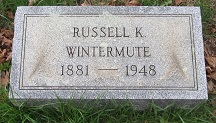 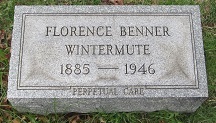 |
| Evergreen Cemetery, Jim Thorpe, PA |
Son Russell Kirby Wintermute (1881-1948) was born on May 12, 1881 in East Mauch Chunk, Carbon County, PA.
Russell was tall and slender, with blue eyes and brown hair.
Mauch Chunk
Times-News
Circa 1908, when he was age 27 and she 23, he wed Florence Benner (June 8, 1885-1946), daughter of Nathan and Mary (Staffer) Benner and a native of Coatesville, PA.

They together produced a brood of two children -- Adele Benner Kreamer and Rev. Gail Benner Wintermute Sr.
In 1910, when the census was taken, Russell and Florence lived with his parents in Mauch Chunk, and he was employed as a salesman in a drug store.
As World War I raged in Europe, Russell registered for the military draft in September 1918, stating his occupation as a clerk with the Central Railroad of New Jersey shops in Mauch Chunk. Over time, he also was employed in the Central's store department in Bethlehem.
They were members of the Grace Methodist Church, and he was affiliated with the International Order of Odd Fellows and the Masons lodge in Mauch Chunk. Florence was a member of the Order of the Eastern Star. Their address in the 1940s was 21 West Fifth Street in East Mauch Chunk.
Mauch Chunk
Times-News
Florence was diagnosed in about 1945 with amyotrophic lateral sclerosis, otherwise known today as "Lou Gehrig's Disease," with deterioration of muscles throughout the body. She died on Sept. 1,
1946, at the home of their married daughter Adele Kreamer in East Mauch Chunk.
She was age 61. An obituary appeared in the Mauch Chunk Times News.
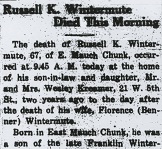
Russell was burdened at the end with "pernicious anemia" -- a deficiency of red blood cells. After a heart attack, he joined his bride in death exactly two years later on Sept. 1, 1948, at age 67. His obituary in the Mauch Chunk Times-News noted that he was survived by three grandchildren.
They are buried together at Evergreen Cemetery. An inscription on the face of Florence's marker indicates that the family plot of graves is perpetually maintained.
Daughter Adele Benner Wintermute (1913-1992) was born on June 18, 1913. Circa 1929, she was a freshman at East Stroudsburg State Teachers' College. On July 28, 1934, Adele married Wesley C. Kreamer (1905-1988), son of Charles H. and Julia (Stermer) Kreamer Sr. Their marital union endured the highs and lows of nearly 54 years until the separation of death. Three known daughter of the pair were Jean Llewellyn, Janet K. Foley and Suzanne Kreamer. Wesley was a proprietor of Kreamer's Store on Center Street along with his father and then brother Charles Jr. For 41 years, he was a director of Jim Thorpe National Bank. In 1948, the Kreamers lived at 21 West Fifth Street in town. That year, Adele's father died in their home. Their hometown of Mauch Chunk was renamed "Jim Thorpe" in 1954 in honor of the famed athlete who was buried locally. In 1959, when Adele's uncle James A. Munro passed away in Wilkes-Barre, she was named in the Jim Thorpe Times-News obituary as a surviving niece. The pair belonged to Grace St. Paul's Methodist Church, where Wesley served as Sunday School superintendent for half-a-century. They marked their silver wedding anniversary in 1959. The Kreamers' final address together was 502 Center Street, Jim Thorpe. At the age of 82, in Allentown, Wesley passed into eternity on July 26, 1988. His obituary was published in the Allentown Morning Call. Adele died four years later on Sept. 3, 1992. They rest together in Evergreen Cemetery.
Granddaughter Janet Kreamer (1935-2018) was born on July 22, 1935 in Hazleton, PA. She grew to womanhood in East Mauch Chunk. Janet was joined in wedlock with Thomas Edward Foley ( ? - ? ). They remained together for a remarkable half-century until cleaved apart by death. Two sons in this family were Gary Foley and Thomas Edward Foley Jr. As of 1957, their home was in Halifax, PA. In time they relocated to Orangeburg, SC. Said an obituary, "She enjoyed working as a lab technician for 27 years... She and her late husband were avid golfers and were members of the Orangeburg Country Club." Sadly, at the age of 82, she passed away in the Medical University of South Carolina in Charleston on July 1, 2018. Rev. Peter Wernett presided over the funeral rites. The Orangeburg Times and Democrat printed an obituary.
Evergreen Cemetery
Great-grandson Gary Foley wed Ann and has lived in Orangeburg, SC.
Great-grandson Thomas Edward Foley Jr. has been a companion of Kim Marler and has made a home in Columbia, SC.
- Granddaughter Jean Kreamer ( ? - ? ) was born on (?). She was an alumna of Jim Thorpe High School and the Allentown Hospital School of Nursing. On June 15, 1957, in nuptials held in Grace Methodist Church in Jim Thorpe, PA, she married Donald William Llewellyn ( ? - ? ), the son of William Llewellyn of Summit Hill. Jointly officiating were Rev. Gail Wintermute Sr. and Rev. John Shannon. Jean's bridal portrait was published in a wedding announcement in the Allentown Morning Call. Donald was a graduate of Summit Hill High School and Dickinson College. At the time of marriage, he was a second lieutenant in the U.S. Army Reserve and employed in Allentown by Provident Mutual Life Insurance Company. They lived in Carlisle, PA in 1959 and in St. Augustine, FL in 1988..
- Granddaughter Suzanne Kreamer (1940-2022) was born on March 16, 1940 in Hazleton, PA. She spent her youth in Jim Thorpe, PA. She was a 1958 graduate of Jim Thorpe High School and went on in 1960 to receive a degree with a proficiency in shorthand from Bethlehem Business School. In 1961, Suzanne tied the knot with Rev. X. Peter Wernett ( ? - ? ). He received a bachelor's degree in business administration from Norwich University, a degree from the Moravian Theological Seminary and a master of divinity degree from Princeton Theological Seminary. Ordained in the United Methodist Church, Peter served for eight years as a pastor of congregations in the Eastern Pennsylvania Conference and for two years on the staff of the General Board of Global Ministries. For four years, he consulted with Global Ministries in leading United Methodist Conferences through strategic congregational development and in the 1970s moved to Chicago working for another four years on the staff of Christian Laity of Chicago, providing Bible study and support to professionals in the Windy City. During another four-year assignment, he was a staff member of Faith at Work. In 2007, he was one of the founding principals of MissionInsite and over the span of 16 years has been a principal with Percept, Inc. in development of clients, including a three-year term as president. They relocated to Mission Viejo, CA and held a membership in the Laguna Beach United Methodist Church with roles as trustee and board leadership and executive committee. In more recent years he has served on the board of Claremont School of Theology.
In her own right, when the family moved to Columbia, MD in the late 1970s, Suzanne "began a successful ten-year career as an executive assistant to pioneering urban renewal developer, James Rouse," said an obituary. "During her time at the Rouse Company, Suzanne was inspired by Rouse and his work, including the Indoor Mall of Faneuil Hall in Boston, the Inner Harbor in Baltimore and development of Columbia. After a move back to Pennsylvania, in the 1980s, Suzanne served as personal secretary to Christian writer Bob Raines, at Kirkridge Retreat Center, PA, and Executive Assistant to the Treasurer, East Stroudsburg University in PA. During these years, Suzanne, also enjoyed ten summers with her family in Ocean Grove, NJ." They moved in about 1993 to Southern California, with her assisting Peter at Percept and becoming active with the Laguna Beach United Methodist Church in such ways as music, special events and vacation Bible School as well a seat as the executive committee. She was known for "unending warmth, compassion, and encouragement [who] had a knack of making others feel special by her personal letter writing and cards."
Suzanne and Peter are the parents of a trio of daughters -- Julia Susan McInerny, Joan Wernett and Jennifer Ann Love. Sadness blanketed the family when Suzanne was diagnosed with B-cell lymphoma and passed into the arms of the heavenly host on March 6, 2022. A celebration of life was held in the family church and in Jim Thorpe, where her remains were laid to rest in Evergreen Cemetery.Great-granddaughter Julia Susan Wernett ( ? - ? ) - She exchanged marital vows with Justin McInerny ( ? - ? ), son of Francis W. McInerny of Quechee, VT.
Great-granddaughter Joan Wernett ( ? - ? )
Great-granddaughter Jennifer Ann Wernett ( ? - ? ) was born on (?). On Nov. 24, 2001, she entered into marriage with Daniel Tracy Love ( ? - ? ). Their wedding was conducted in the Laguna Beach United Methodist Church.
Son Rev. Gail Benner Wintermute Sr. (1916-2004) was born on May 19, 1916 in East Mauch Chunk. He was a graduate of Dickinson College and then Drew Seminary. Gail entered into marriage with Mildred L. Young ( ? -2011). Their union endured over the ebbs and flows of a remarkable 58 years' duration. The couple bore two children -- Louise Georgette Gelotte and Gail Benner Wintermute Jr. He was a minister in the Methodist Church for nearly six decades. Among his charges were Scranton, Springville, Bird-in-Hand, Hawley, Lakeville and Paupack. He was a member of the Wyoming Conference of the United Methodist Church, and after retiring in 1980 joined the Beach Lake United Methodist Church. He died at the age of 88 on Nov. 13, 2004, in Hawley, Wayne County, PA. Burial was in the Fairview Cemetery in Pen Argyl, Northampton County, PA, with Rev. Dr. Gordon E. Weightman officiating. A lengthy obituary was published in the Wayne Independent. (link) Mildred outlived her spouse by seven years and went to live in Wesley Village in Pittston. She passed away at the age of 87 just two days before Christmas 2011. Cremation took place. Her obituary appeared in the Scranton Times-Tribune.
- Granddaughter Louise Georgette Wintermute ( ? - ? ) entered into marrige with (?) Gelotte ( ? - ? ). Her dwelling-place in 2004 was Sedona, AZ.
- Grandson Gail Benner Wintermute Jr. ( ? - ? ) was born on (?). On March 28, 1981, he was united in matrimony with Debra Snyder ( ? - ? ), daughter of Fred and Jane Snyder. Their wedding was held in the Myrtle Street United Methodist Church, with the nuptials jointly led by Gail's father and Rev. Dr. Jonathan King. They put down roots in Scranton and went on to become the parents of two -- David Wintermute and Sara Wintermute. Gail is believed to have operated a Multiple Sclerosis self-help group in Scranton, while Jane worked for Medical Associates of Northeastern Pennsylvania. In 2006, at their silver wedding anniversary, they were pictured in the Scranton Times-Tribune.
|
Copyright © 2011-2013, 2024 Eugene F. Podraza and Mark A. Miner |
|
Chancellorsville sketches originally published in Famous Leaders and Battle Scenes of the Civil War. |

